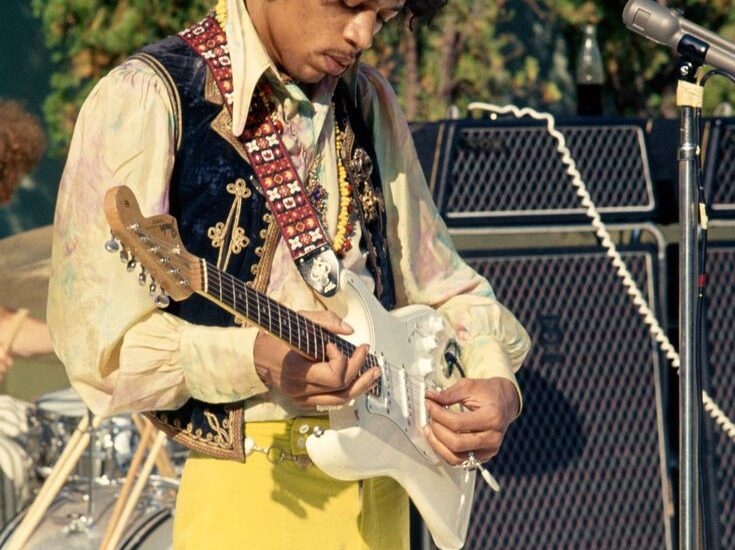
Just In:**Jimi Hendrix** (1942–1970) revolutionized the electric guitar with his innovative and daring playing style……
Jimi Hendrix is often hailed as one of the greatest and most influential musicians in history, known for his exceptional skill, bold experimentation, and revolutionary approach to the electric guitar. Born on November 27, 1942, in Seattle, Washington, Hendrix’s career, though tragically short, transformed the music world in ways that continue to resonate today. His electric guitar mastery, unique sound, and ability to blend diverse genres changed rock music forever, leaving an indelible mark on both musicians and fans.
Early Life and Musical Beginnings
Born Johnny Allen Hendrix to Al Hendrix and Lucille Jeter, Jimi’s early years were shaped by hardship. His parents separated before he was born, and he was raised by his father, who later changed his son’s name to James Marshall Hendrix. Music was a constant presence in his home; his father played guitar, and Jimi’s early exposure to rhythm and blues music influenced his later work. Despite his family’s financial struggles, Hendrix was given his first guitar at the age of 15, sparking his deep interest in music.
In his early teens, Hendrix played in various bands and began to develop his unique sound. However, it wasn’t until he moved to Nashville in 1962 and became a session guitarist that his talents began to attract attention. He worked with several artists, including Little Richard, The Isley Brothers, and Curtis Knight, learning the art of performance and honing his skills. His time as a session musician allowed him to experiment with a wide range of genres, including blues, soul, and R&B, all of which would later influence his own musical creations.
Rise to Fame
Hendrix’s big break came when he moved to London in 1966. There, he formed the Jimi Hendrix Experience with bassist Noel Redding and drummer Mitch Mitchell. The trio quickly gained attention with their electrifying live performances and innovative sound. Their debut single, “Hey Joe,” became a hit in the UK, and the album Are You Experienced (1967) solidified Hendrix’s reputation as a groundbreaking musician.
Are You Experienced featured a unique blend of psychedelic rock, blues, and hard rock, marked by Hendrix’s distinctive guitar tone and virtuosic solos. Tracks like “Purple Haze,” “Foxy Lady,” and “The Wind Cries Mary” displayed not only his technical prowess but also his ability to experiment with distortion, feedback, and various effects. Hendrix’s sound was unlike anything audiences had heard before, with a fusion of genres that set him apart from his contemporaries.
The release of Axis: Bold as Love (1967) further cemented his place in music history. This album expanded on the ideas introduced in Are You Experienced, pushing the boundaries of studio recording and blending various musical styles. The song “Little Wing,” one of Hendrix’s most beloved tracks, exemplified his ability to fuse technical guitar skills with deep emotional expression.
The Woodstock Era: A Cultural Icon
One of the defining moments of Jimi Hendrix’s career came in 1969 when he performed at the Woodstock Music & Art Fair. The festival, which was a celebration of peace, love, and countercultural ideals, was the perfect stage for Hendrix’s larger-than-life persona. His rendition of “The Star-Spangled Banner,” performed on electric guitar, is one of the most iconic performances in rock history. Using distortion and feedback, Hendrix transformed the national anthem into a powerful and emotional protest against the Vietnam War, with his guitar wailing as if to capture the turbulent political climate of the time.
At Woodstock, Hendrix’s musicality and stage presence captivated an audience of hundreds of thousands. His ability to seamlessly blend rock, blues, jazz, and psychedelia showcased his versatility and established him as a cultural figurehead of the 1960s. His performance was not just a musical achievement but a symbol of the rebellious spirit of the era, solidifying his status as one of the most influential artists of the time.
Guitar Revolution: Pushing the Boundaries of Sound
Jimi Hendrix’s contributions to the world of music were not limited to his songwriting and performance. He is widely credited with revolutionizing the electric guitar, pushing its technical and sonic boundaries in ways no one had done before. Hendrix was one of the first musicians to explore the full potential of guitar effects like distortion, fuzz, and delay. He also pioneered techniques such as feedback manipulation and the use of the wah-wah pedal, allowing him to produce sounds that were previously unimaginable.
One of his signature techniques was the use of finger vibrato and a heavy use of the whammy bar to create unique, expressive pitches.
You may also like
Archives
Categories
- ABA
- Actor
- Actress
- Actress and singer
- Band
- Baseball
- Basketball
- Boxer
- Broadcasting corporation
- CCR
- cricketer
- Cyclists
- Dart
- Drummer
- Fictional character
- Football game
- Formula 1
- Golf
- Guitarist and songwriter
- Guitarists
- Gymnastics
- Hockey
- Ice hockey
- Marathon
- MLB
- Motocross
- MotoGP
- Musician
- Musician and drummer
- NFL
- NHL
- NRL
- Racer
- Red bull Racing
- Rider
- Rock band
- Rugby league
- Simone Biles
- Singer and songwriter
- Songwriter and musician
- Sport commentator
- Tennis
- Texas longhorns
- Track and field athlete
- Uncategorized
Leave a Reply